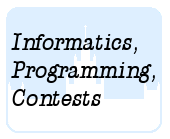Подразделы
| 975. Метрополитен |
| 976. Очень легкая задача |
| 977. Шахматная доска |
| 978. Интересный треугольник |
| 979. Galaxy |
| 980. Robot |
| 981. Schedule |
| 982. Ancestor |
| 983. Grid |
| 984. Hosting |
| 985. BitSort |
Дата и время
06/12/2025 05:42:17
 Лето 6
Лето 6
A. Метрополитен B. Очень легкая задача C. Шахматная доска D. Интересный треугольник E. Galaxy F. Robot G. Schedule H. Ancestor I. Grid J. Hosting K. BitSort
 F. Robot
F. Robot
 Поиск в ширину (BFS)
Поиск в ширину (BFS)Олимпиадные задачи на английском языке

| 03/07/2008 | Лето 2008 дорешивание ( 6F) |
| 14/07/2008 | Лето 2008 - 6 (F) |
Ограничения: время – 1s/2s, память – 16MiB Ввод: input.txt или стандартный ввод Вывод: output.txt или стандартный вывод 
Послать решение Blockly Посылки Темы Где Обсудить (0)
Robot has to patrol around a rectangular area which is in a form of `m\ times\ n` grid (`m` rows and `n` columns). The rows are labeled from 1 to `m`. The columns are labeled from 1 to `n`. A cell `(i,\ j)` denotes the cell in row `i` and column `j` in the grid. At each step, the robot can only move from one cell to an adjacent cell, i.e. from `(x,\ y)` to `(x+1,\ y)`, `(x,\ y+1)`, `(x-1,\ y)` or `(x,\ y-1)`. Some of the cells in the grid contain obstacles. In order to move to a cell containing obstacle, robot has to switch to turbo mode. Therefore, the robot cannot move continuously to more than `k` cells containing obstacles.
Your task is to write a program to find the shortest path (with the minimum number of cells) from cell `(1,\ 1)` to cell `(m,\ n)`. It is assumed that both the cells do not contain obstacles.
Input
The first line contains three positive integers `m`, `n` and `k` (`1\ ≤\ m,\ n\ ≤\ 100`, `0\ ≤\ k\ ≤\ 100`). The `i`-th line of the next `m` lines contains `n` integer `a_{ij}` separated by space (`i\ =\ 1,\ 2,\ …,\ m`; `j\ =\ 1,\ 2,\ …,\ n`). The value of `a_{ij}` is 1 if there is an obstacle on the cell `(i,\ j)`, and is 0 otherwise.
Output
If there exists a way for the robot to reach the cell `(m,\ n)`, write the number of moves the robot has to make; `-1` otherwise.
Sample Input 1
2 5 0 0 1 0 0 0 0 0 0 1 0
Sample Output 1
7
Sample Input 2
4 6 1 0 1 1 0 0 0 0 0 1 0 1 1 0 1 1 1 1 0 0 1 1 1 0 0
Sample Output 2
10
Sample Input 3
2 2 0 0 1 1 0
Sample Output 3
-1

 Начало
Начало